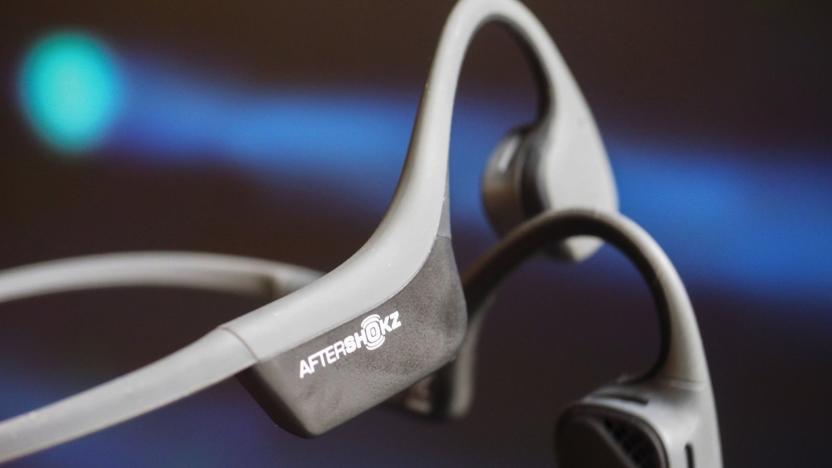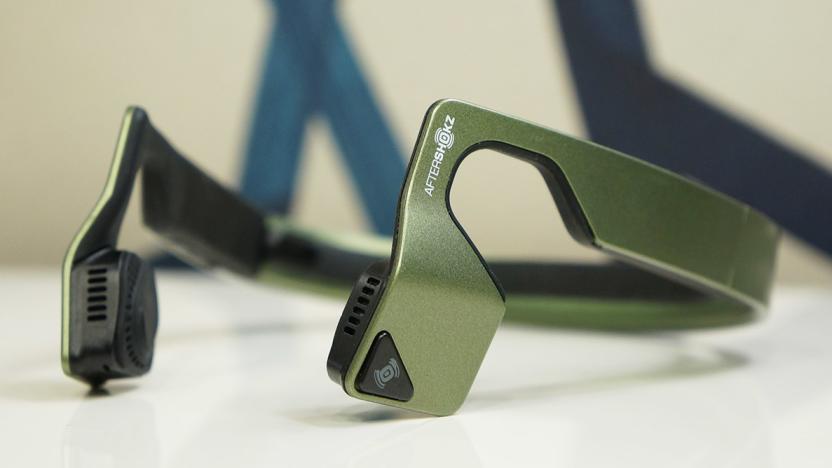BoneConduction
Latest

OptiShokz built bone conduction audio sunglasses
Keeping your ears open to the environment is key when riding a bike or otherwise needing to stay aware of your surroundings, but music is life right? The AfterShokz Trekz Titanium and Air series have been filling that need quite well for a while, but the company has broken away into new avenues for this year's models, with all the requisite z's still in place. Today the company has announced the AfterShokz Xtrainerz MP3 headset, along with its sister company OptiShokz's Revvez bone conduction audio sunglasses. The Xtrainerz should hit the market in Q2 2019 with a price of $149.95. Revvez are heading to Indiegogo on February 19th, 2019 for the crowdfunding treatment with an early bird price of $99 (MSRP $179). I managed to get my hands on some pre-production versions of both here at CES and overall, they seem worth a look, slotting nicely into some new categories.

Aftershokz unveils its skinny Trekz Air open-ear headphones
When Aftershokz released its Trekz Titanium bone-conduction headphones, there was a marked change from the Bluez 2 line before it. The design shifted from a stiff plastic headband to a ruggedly flexible and sportier design. Today at IFA in Berlin, the company is launching the next step in the series called Trekz Air with a retail price of $150 and pre-orders beginning September 1st (in the US). The overall style and concept remain the same, except for the 17-percent lighter weight and visibly slimmer silhouette. I've been using the Titanium model on my bike rides for the past year and have enjoyed the more casual fit, but this new model that I tested for two days really raises the bar in terms of comfort. It's worth noting, though, that in a side-by-side comparison, I found this slimmer package may have lost a tiny bit of oomph in terms audio output -- but that slight tradeoff might be worth it.

Orii smart ring turns your fingertip into a Bluetooth earpiece
While modern Bluetooth earpieces are more compact than ever, chances are you'll still need to leave at least one stuck in your ear. This can get uncomfortable over time, not to mention the dorkiness that's been haunting this form factor since day one. Hong Kong startup Origami Labs thinks it has an alternative solution to this problem: why not repackage the Bluetooth earpiece as a ring, and then use bone conduction to transmit audio to the fingertip? That's the basic concept behind the Orii smart ring.

ICYMI: Finger speakers and sumo-bots and mini-silk screens
Today on In Case You Missed It: The SIGNL strap Kickstarter campaign wants to put a private phone speaker at the tip of your finger. Plus, Japan combines its two favorite past times -- the graceful art of sumo and autonomous robots -- into a kickass, white-knuckle sport. try{document.getElementById("aol-cms-player-1").style.display="none";}catch(e){}

ICYMI: 3D-printed, autonomous bus starts shuttling people
try{document.getElementById("aol-cms-player-1").style.display="none";}catch(e){}Today on In Case You Missed It: Local Motors is testing a self-driving, electric mini-bus that lets passengers communicate with the bus about the weather and where they're located as they are shuttled from one part of town to another. The bus was conceived just a few months ago but is already running in Maryland. The company plans to bring more buses to other cities, like Copenhagen and Las Vegas, soon. Meanwhile bone conduction headphones are being reimagined to be more wearable, with both a sunglasses option and helmet version up for grabs online. We also wanted to show you video of the robot badminton player because it's pretty amazing. As always, please share any interesting tech or science videos you find by using the #ICYMI hashtag on Twitter for @mskerryd.

Log in with your skull via bone conduction biometrics
Researchers looking for a better way to secure their face computers have come up with a novel solution for hands-free, head-mounted password entry. A device could potentially identify its wearer by emitting an ultrasonic hum through their skull and listening for the unique frequency that bounces back.

Microsoft updates navigation headset for the blind
In 2011, Microsoft UK teamed up with charity Guide Dogs to create 'Cities Unlocked,' an organization that worked to create a headset designed to help the visually impaired. That device came last year, but now it's received some major hardware and software upgrades. Although the original simply used bone conduction to send audio clicks and cues to guide the user around, the latest iteration is less of a practical tool and more of an information-rich service. It uses something called "3D soundscape technology," which is kind of like a GPS that describes everything that's around them, from local cafés to alerts telling them when a bus or train is approaching the stop.

Bone conduction headphones let me ditch the boombox, but still cycle safely
Long bike rides are an easy way to burn calories without terrorizing your knees, but it helps to have some tunes to keep things fun. My rides usually take me through bustling urban streets and isolated stretches of waterfront, so pumping out a soundtrack using a Bluetooth speaker is usually a viable option -- mostly, anyway. Unfortunately, the wind-dampened output is never ideal and a high audio volume can burn through battery life, and bringing a backup device adds weight. Luckily, the ideal solution recently crossed my desk: AfterShokz's Bluez 2S bone-conduction headphones.

Microsoft's bone-conducting headset guides the blind with audio cues
While nothing can replace the companionship of a guide dog, technology can help make treks through busy cities a lot less stressful and more enjoyable for the visually impaired. Microsoft, for one, is currently testing a new headset (developed with help from UK charity Guide Dogs) that uses 3D soundscape technology to guide its users with audio cues along the way. That bone-conducting headset can't work alone, though: it needs to be connected to a smartphone, as well as to receive information from Bluetooth and WiFi beacons placed in intervals throughout the roads users take. For its pilot program, Microsoft attached makeshift beacons on neighborhood objects in a London suburb, where its first testers are giving it a spin. When company news writer Jennifer Warnick tried it out while blindfolded, she found herself so efficient in getting around with only sounds to guide her, that she felt like a "dry-land dolphin."

Lenovo's Google Glass-like wearable concept keeps your voice chats private
Even Lenovo isn't immune from the temptation to produce a Google Glass-like wearable display, it seems. The Chinese tech giant has applied for a US patent on a headset design with dual screens, touch-based navigation and an unusually strong emphasis on voice quality. Rather than use conventional noise-canceling microphones, like Google, Lenovo would use a bone-conducting microphone just above your nose bridge. The approach would make it easier to catch your voice, since you wouldn't have to compete with outside sounds for attention; it could also offer an extra level of privacy for internet calls, since you could speak quietly and still get your message across.

Google patent application reveals Glass-like device with bone-conduction audio
As we've heard before, Google's Glass project features are "still in flux" -- could one be a bone-conduction speaker? It very well may, at least according to a US patent application published today. The gadget, described as a "wearable computing device with indirect bone-conduction speaker," appears to be similar in structure to Glass. It includes "at least once vibration transducer," so it's possible that this HMD implementation wouldn't offer stereo sound. This audio solution does seem within reach -- Panasonic had functional bone-conduction headphones at CES, and while they weren't quite loud enough to provide an earbud-like experience, they did indeed work. As with any patent application, the document confirms only that Google was considering such a technology, not that it'll actually ship a similar device. So, if you've decided that your portable audio future will be headphone-free, you might want to keep an eye on Panasonic's solution, instead.

Panasonic announces bone conduction headphones, we go temples-on
This year, Panasonic's pretty much gone all out with a vast range of gadgets. Tablets, TVs, Touch Pens, cameras, and outrageous Hi-Fi. One smaller addition to the company's portfolio was a pair of bone conducting Bluetooth headphones. The technology isn't exactly new, but as more and more companies get onboard, they start edging their way into the mainstream. Panasonic's take on them looks -- at least initially -- like a good start. At first, the design looks almost like any other wrap-around pair of sports headphones. Until, of course, you inspect closer, and realise that there aren't actually any buds to place in your ears. The soft-touch outer material around the ear-hooks makes them feel nice in the hand, and adds to the sporty look. Unusually they are powered by a single AAA battery, that you sneak into the slightly bulbous section in the middle of the band. We were told, however, that this might change to a rechargeable solution when we get closer to the projected fall release window. We were eager to see how the audio performed, but it's fair to say that on a rowdy show floor this was pretty difficult. We were advised to put our fingers in our ears to initially hear the music, and then remove them while focusing on the music. In reality, even with ears fully plugged, hearing the demo song was pretty difficult. With ears fully open to the ambient noise, we couldn't hear anything at all. The representative was sure to advise us that production models would be two to three times louder, and we'd go as far to say that even that might not be enough. One thing is for sure, they did definitely work, and the effect is still impressive. The product is pitched at more active use cases though, so it will be interesting to see how they work while on the move / run. Again, something that was a little difficult for us to explore, despite really wanting to. As stated above, these should see the light of day sometime in fall, and we really do hope they are louder. Price-wise, there's no official word, but if you imagine $200 as a ballpark figure, you might not be too far off the mark. Billy Steele contributed to this report.

AfterShokz to debut 'world's first' bone-conducting Bluez headphones at CES 2013
At first glance, you might think the guy in the photo above is wearing his sunglasses backwards. However, he's actually getting hiz groove on with the AfterShokz Bluez, a pair of Bluetooth headphones that transmits audio using bone conduction. We've seen the technology before, but never on stereo wireless headsets. Instead of vibrating your eardrums, the Bluez use transducer pads that sit on your cheekbones to send audio directly to your ears. As such, the headphones have an "open-ear" design, presumably to let you hear your surroundings while listening to tunez. If this zoundz intriguing, you can pre-order them for $100 (despite their $129 retail price) from the company's website, or just wait until January when they will make their official debut at CES 2013.

Mouth-based bling MP3 player puts your tunes on retainer
It's time to give your pockets a rest. Take a cue from Parsons student Aisen Chacin and stick your MP3 player where it belongs: in your mouth. The catchily-named Play-a-Grill combines bone-conducting music playback with a classic bit of bling-based technology. This "attempt to provide an unusual display and interface in comparison to typical audio/visual stimulation and digit based control panel" utilizes an iPod Shuffle knockoff, which sits in the roof of the wearer's mouth for some good, old fashioned tongue control over music playback. At the moment, the player looks to be more art project than consumer product (complete with a Nelly-quoting paper), but perhaps this is the iPod killer everyone's been searching for all along.

Aquapulse heart rate monitor finally ships, misses out on Michael Phelps fervor
It's not often that a product takes two full years to go from announced to shipped, but such is the case with Finis' Aquapulse. For those who weren't exactly paying attention in April of 2009, the aforementioned company busted out a head-mounted device that relies on an Infrared sensor to monitor heart rate via your earlobe. Said rate is then communicated to you in real time through bone conduction technology. Naturally, it's fully capable of heading underwater for swimmers and heavy sweaters, but is understanding just how hard your hardest working muscle is working worth $149.99 to you? Hit the source link once you've made up your mind.

Maxell's Vibrabone HP-VBC40 earbuds can rattle your skull, if you'd like
Maxell has taken a slightly different approach to the bone conduction trope with its new Vibrabone HP-VBC40 earbuds – headphones that combine standard stereo drivers with the same bone-rattling, vibration-based technology we've all come to know and love. According to Maxell, the Vibrabone's hybrid system enhances the bass that would be coursing its way through your cranium, while its dual volume control allows users to fine tune that bass flow. Apparently, this bass adjustment mechanism puts less stress on your eardrums, which might make the entire bone conduction concept seem slightly less creepy. The earbuds come in black, blue and white, and will be available in Japan toward the end of April, for a little under ¥4,000 or about $50.

SoundBite dental hearing aid receives European approval
We've already seen the principle of bone conduction be applied to headphones, but Sonitus Medical is taking the idea to a whole new level with its SoundBite dental hearing aid, which has just received the necessary European CE Mark certification (it already has FDA approval). As you can probably surmise, the device is a hearing aid that's placed on your teeth, although it's not actually implanted or attached in any way -- it's simply custom fitted to the person's upper back teeth. The other part of the package is a more standard-type hearing aid unit that's worn behind the ear, which processes and wirelessly transmits to the device in your mouth. That's obviously not intended for cases when a simple hearing aid will do, but Sonitus says the system can help people who are "essentially deaf" in one ear regain their spatial hearing ability.

Augmented reality TagCandy creates a virtual taste explosion (video)
The majority of augmented reality applications these days may be visual ones, but that's hardly the only type of augmented reality possible, as fully evidenced by this so-called TagCandy device built by Yasuaki Kakehi of Keio University. As you can see above, it consists of a rather large base that accommodates a regular lollipop, which not only makes it easy to hold the candy, but uses bone-conduction technology to produce different sounds ranging from fizzy soda to fireworks. Of course, it is just a concept, and still something of a work in progress -- future possibilities apparently include the ability to detect biting in addition to sucking, and the ability to buy and share different "sensations" on the internet. Head on past the break to check it out on video.

Motorola Endeavor HX1 on sale in Sprint stores for $129.99
This one slipped right under our radar, but some Sprint stores have already started taking delivery of the awesome Motorola Endeavor HX1 headset -- so at least one part of the rumor calling it out as a $159.99 Sprint exclusive was true. Fortunately, the pricing part of the rumor was false, because the sticker price you'll find on the shelf is a slightly more palatable $129.99. That's still pricey, yes, but at least it falls in line with the upper echelon of Bluetooth headsets on sale these days. We called around and found that some locations don't have it, some don't expect it until next week, and some already have a few socked away under the counter, so call around before you head out to pick it up.

FINIS AquaPulse monitors, communicates heart rate to swimmers
Now that every kid on planet Earth is attempting to mimic the once-heroic Michael Phelps, it's only fair to equip them with the very best in training tools. FINIS, the same firm that's been cranking out bone conducting underwater MP3 players for years on end, has finally branched out a bit with the introduction of the AquaPulse. By utilizing an Infrared sensor, the device -- which straps onto one's goggles and rests on the temple bone -- can continually monitor heart rate and communicate it audibly to the swimmer via bone conduction in customizable intervals. Unfortunately, FINIS didn't think to integrate music playback into this for moments when it's not dishing out vitals, but you could also rock one of its dedicated music players on the non-dominant ear. Olympians-to-be can catch it this May for $139.99. Full release is after the break.













